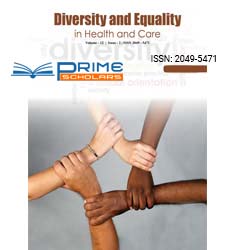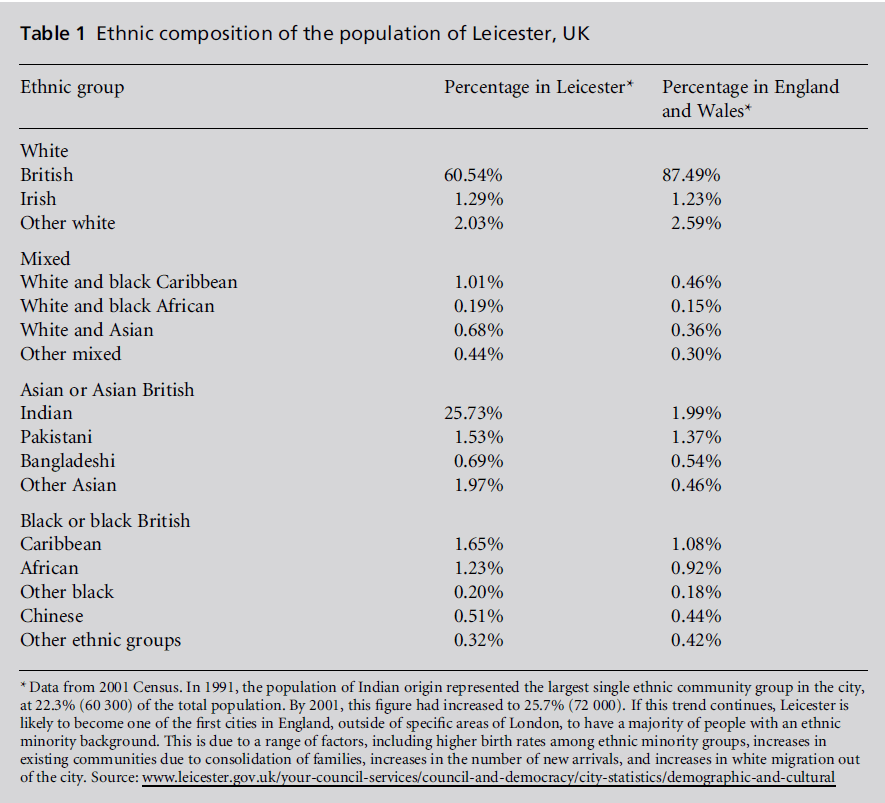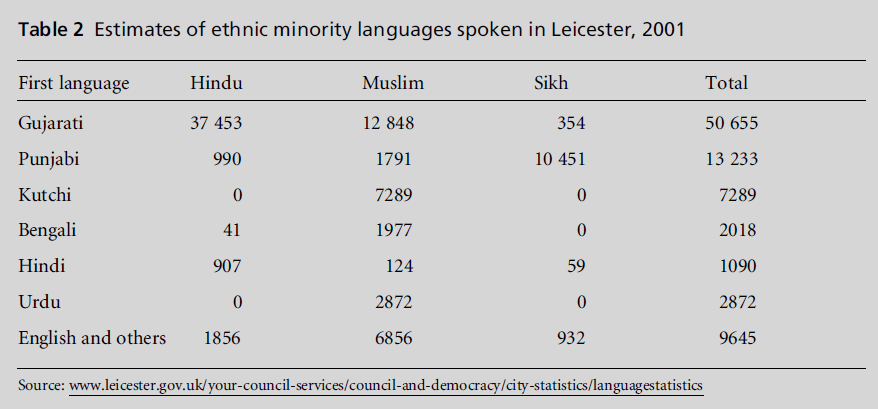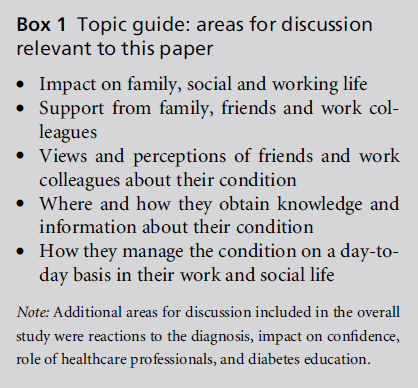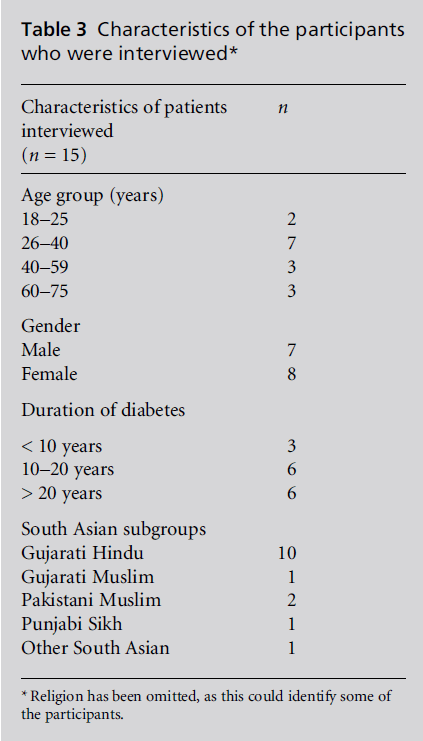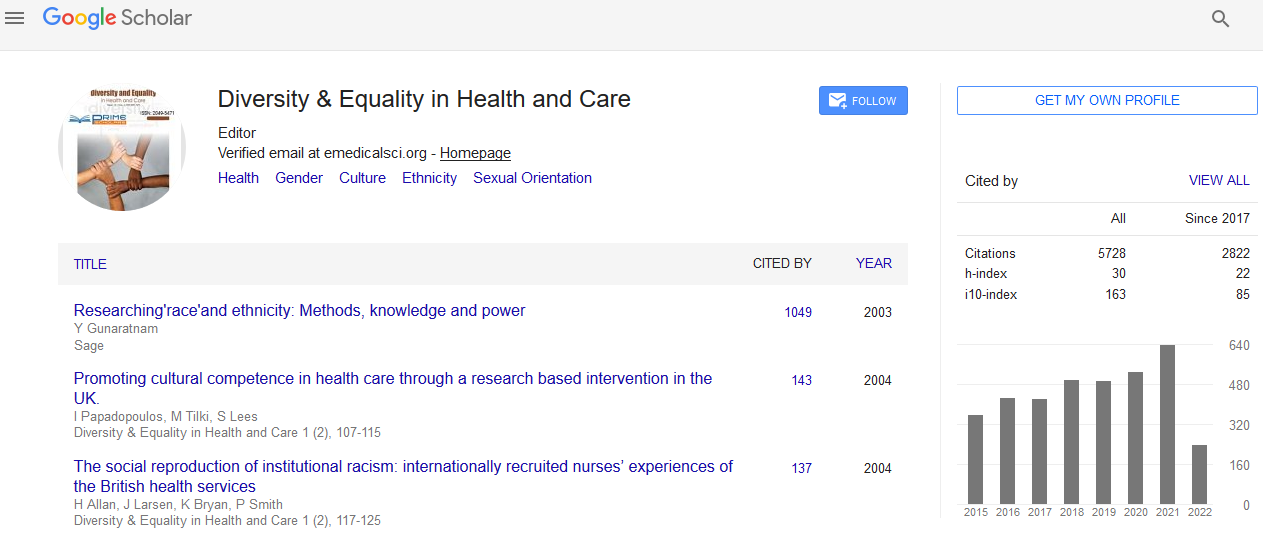What is known on this subject
• The incidence of type 1 diabetes in the South Asian population in the UK is increasing.
• There is a paucity of research on the attitudes and beliefs that influence and affect self-management of this
condition in the South Asian population.
What this paper adds
• For pragmatic reasons, people with type 1 diabetes are generally willing to disclose their need for insulin.
However, in some people of South Asian origin, there may be an exception regarding disclosure where
marriage prospects are an issue.
• Those involved in diabetes management need to be aware of the social and cultural context of patients. For
South Asian patients, this may include awareness of issues such as marriage prospects which may have an
impact on physiological and psychological well-being.
Keywords
disclosure, qualitative methods, South
Asian, type 1 diabetes mellitus
Introduction
There is limited knowledge of the experiences, attitudes
and beliefs that influence the management of
type 1 diabetes among people of South Asian origin
living in the UK. This may be due, in part, to a perception
that type 1 diabetes is an uncommon condition
in South Asian people. Some previous studies
support this view in reporting a lower incidence of the
condition, compared with the UK, in both South India
(Ramachandran et al, 1992) andPakistan (Staines et al,
1997), but there has been very little research on this
issue. However, the incidence of diabetes in people of
South Asian origin living in the UK appears to be
increasing, so that it is now similar to that of the white
British population (Bodansky et al, 1992; Raymond
et al, 2001; Feltbower et al, 2002). The incidence of
type 2 diabetes is also increasing in this population,
and recent evidence suggests that social, culturally
based attitudes and beliefs shape and influence experiences
of managing this condition (Stone et al, 2005;
Lawton et al, 2006). In this context, insulin therapy
is particularly important. Studies of other minority
groups (Latinos and African-Americans) indicate that
the management of insulin therapy is influenced by
the social context. Feelings of anxiety, shame or embarrassment
may lead people with diabetes to avoid
injecting at work or in social environments (Tak-
Ying Shiu et al, 2003). This may adversely affect their
glycaemic control and contribute to the development
of complications such as neuropathy and retinopathy
(Liburd et al, 2004; Gee et al, 2007; Weiler and Crist,
2009). The complications of diabetes have a permanent
and deleterious effect on health, and on quality
and length of life. It is therefore important to understand
the contexts in which people live, so that education
about their condition can be tailored to help
them to cope with the challenges ahead.
Aims of this study
The findings reported here are drawn from a larger
study on insulin therapy among South Asian adults
with type 1 diabetes living in Leicester, UK, which will
be the subject of another publication. Tables 1 and 2 provide information about the ethnic composition of
Leicester. This paper focuses on one of the main
themes from this study, namely the perceptions of
South Asian people with type 1 diabetes with regard to
other people’s attitudes to insulin therapy, and the
impact of these attitudes on their willingness to disclose
their status as individuals who require insulin.
Methods
The study was informed by the principles of grounded
theory, which ensures that themes emerge from the
data, but we also recognised that some of the areas
explored during the interviewswere predetermined by
the research aims (Strauss and Corbin, 1990).
Leicestershire, Northamptonshire and Rutland Research
Ethics Committee provided a favourable ethical
opinion.
Sampling
Purposive sampling was used to capture the views of a
range of South Asian people with diabetes in terms of
age, gender and number of years since diagnosis. The
eligibility criteria were a diagnosis of type 1 diabetes,
age 18 years or over, and ability to speak English or
Gujarati. Individuals who were unable to give informed
consent and/or who were considered by healthcare
professionals involved in their care to be unsuitable
for the study were excluded.
Consent
Table 1: Ethnic composition of the population of Leicester, UK
Table 2: Estimates of ethnic minority languages spoken in Leicester, 2001.
Eligible participants were approached at two specialist
care diabetes outpatient clinics between October 2008 and May 2009. Initially a member of the clinic staff
provided information about the study to patients. If
individuals expressed an interest in participating, they were then introduced to the researcher (NP), who is
fluent in both English and Gujarati. She discussed the
study with them, gave them written information about it (in English or Gujarati), and obtained their
initial written consent and permission to record their
contact details in order to arrange the interview. A
minimum period of 24 hours was allowed to elapse
before the researcher contacted them by telephone to
arrange a mutually convenient time for an interview.
Full written consent was obtained at the start of the
interview.
Data collection and analysis
In-depth interviews took place in participants’ homes
and were informed by a topic guide (see Box 1). This
was used flexibly to enable participants to tell their
stories as they wished. The interviews were audiorecorded
and transcribed verbatim. Those conducted
in Gujarati were translated into English by the researcher
(NP). A random sample of these translated
transcripts, together with anonymised audio recordings,
was assessed by an independent professional translator,
who confirmed the linguistic accuracy and conceptual
equivalence of the translations. The interview
transcripts were reviewed (by NP and MAS) throughout
data collection as part of an ongoing process of
topic guide development. For example, emerging themes
relating to negative perceptions, disclosure of diabetes
status and marriage prospects were more specifically
explored in later interviews. Regular review of transcripts
also helped to identify when saturation had
occurred.
All of the transcripts were open coded by one
member of the team (NP), and a random selection
was independently coded by two other members of the
team (MAS and HE). Discussions (by NP, MAS and
HE) led to the development of an initial coding frame
incorporating both descriptive and conceptual (interpretative)
categories. Further discussions (by NP, MAS
and HE) took place to adapt and refine the coding frame on an ongoing basis during the subsequent
process of progressive focusing and systematic coding
(Charmaz, 2006). This led to the development of a
final thematic framework that was mutually agreed by
the researchers (NP, MAS and HE). This included
agreement about the positioning of higher-order themes
and sub-themes within the coding frame. Framework
charting (Ritchie and Spencer, 1994) was subsequently
used to organise the data in accordance with these
themes, to facilitate further exploration and interpretation.
This included exploring relationships within the
charted data in terms of both cases (interviewees) and
themes. Throughout the process of analysis, care was
taken to ensure that findings were grounded in the
data collected (Strauss and Corbin, 1990). Qualitative
software (QSR N6) was used for data management
during the coding phases of the analysis.
Box 1: Topic guide: areas for discussion
relevant to this paper
Findings
Interview data were obtained from 15 people of South
Asian origin (see Table 3). Themajority of these interviews
were conducted in English (n = 9), and the rest were conducted partly or entirely in Gujarati (n = 6).
The findings presented here are concerned with perceptions
of social stigma and disclosure of diabetes.
Table 3: Characteristics of the participants
who were interviewed.
Influence of other people’s
perceptions on disclosure
The participants reported the negative reactions of
other people on finding out about their diabetes and
their need for insulin therapy. A common factor in these
accounts related to responses about the lifelong need
for daily injections. Examples included the following:
‘Yah, they say ‘‘Oh my God! How can you take injections
for that long?’’’ (Interview 6, in Gujarati, female, aged 60–75 years)
‘When you tell them, they say ‘‘Oh, insulin, diabetes, you
have to have injections every day. Oh, no, no, no good, no
good having them, to take them every day.’’’ (Interview 4, in Gujarati, male, aged 40–59 years)
These reactions were sometimes associated with an
element of blame, and were attributed to a lack of
understanding about type 1 diabetes:
‘Everyone just assumes it’s to do with your diet it was this
assumption, you know, that I’d done something wrong.’ (Interview 19, in English, female, aged 26–40 years)
However, most of the participants appeared to be
willing to disclose their need to take insulin, and did
not mind being asked about their condition or making
it apparent.
‘Because if I take insulin injection I’ve had a few people
asking what, what I am doing because they don’t see it as
normal. Apart from that, um, I personally don’t think it’s
a problem, um, because it’s been in my family. ... So I
don’t see a problem with any, any stigma with that. (Interview 12, in English, male, aged 18–25 years)
Reasons for willingness to disclose
diabetes status
Participants’ responses suggested that they made conscious
decisions to disclose their diabetes and that this
was motivated by pragmatism. They described a number
of ways inwhich disclosure helped. These included
enabling them to eat on time when attending social
events, to inject in public or at work, and to make
others aware of the possibility of hypoglycaemia and
what to do if it occurred. For instance:
‘I have to take it at six o’clock in the afternoon, the latest I
take it is 1.30 pm. I inject, even if I wear a sari or Punjabi
suit [indicates use of plate to hide it] if I go to a wedding I
keep my insulin with me and when it’s time I take it.’
(Interview 27, in Gujarati, female, aged 40–59 years)
‘You have to let work know, friends circle there, let the
supervisor know, sometime, people say if your blood
sugar goes really low and you fall down, if nobody knows,
then they are going to get confused, what’s happened to
him, is it a heart attack or low sugar, nobody will know. If
the ambulance people come they won’t know either.’
(Interview 4, in Gujarati, male, aged 40–59 years)
One participant viewed disclosure as a way of educating
other people about this condition:
‘It can help other people if we talk like this. So it’s better to
talk.’
(Interview 10, in Gujarati, male, aged 40–59 years)
Two male participants described a more strategic
approach to disclosure, on a need-to-know basis.
This appeared to be linked to attitudes to privacy
rather than concern about being stigmatised:
‘It’s quite common these days, it seems you always tend to
know someone that has diabetes, so it’s not really a major
issue about sort of not wanting people to know, but rather
simply the fact that I don’t, don’t feel the need to tell
everyone.’
(Interview 25, in English, male, aged 26–40 years)
‘Well I share with people I need to share with. I don’t, if I
go to the temple I wouldn’t necessarily say I’m diabetic, I
can’t do this, do that. I just say I don’t want it and that’s
fine.’
(Interview 15, in English, male, aged 40–59 years)
Disclosure in the context of marriage
prospects
An issue relating to marriage prospects emerged
during the interviews. In this context, some unmarried
participants described a more inhibited approach
to disclosure:
‘When I’m introduced to people, or to guys especially, I
wouldn’t normally tell them the first time I meet them,
but eventually I will. And it’s always that thing, when do
you tell someone or when you don’t because that’s
probably the only situation where, um, it has been used
against me. That yeah, you’re a lovely person, we like you,
but because you’re diabetic, no.’
(Interview 19, in English, female, aged 26–40 years)
‘I haven’t actually got to that stage yet, but it is one of the
things that does worry me because initially when I meet a
person I wouldn’t tell them ‘‘OK I’m type 1 diabetic’’,
because you don’t even know that, if you’re gonna go any
further, with that person or not.’
(Interview 20, in English, female, aged 26–40 years)
One of the women went on to describe pressure from
other people, including her parents, not to disclose
diabetes until a marriage has taken place:
‘my parents included, will say ‘‘Don’t tell them, they will
find out after the marriage once you’re married it doesn’t
matter then. They’re gonna have to put up with it.’’’
(Interview 19, in English, female, aged 26–40 years)
An older participant confirmed that even if young
people themselves feel uninhibited about disclosure,
their parents might still have concerns about compromising
their marriage prospects:
‘These days the children themselves they mingle with each
other and they do know about these things, but their
parents if it is for the sake of arranged marriages they
won’t discuss any illness.’
(Interview 26, in English, male, aged 40–59 years)
However, another older woman took a different view.
She described how she disclosed her own son’s type 1
diabetes:
However, another older woman took a different view.
She described how she disclosed her own son’s type 1
diabetes:
(Interview 13, in English, female, aged 40–59 years)
The main concern that emerged about the effects of
disclosure on one’s marriage prospects was associated
with perceptions about the hereditary nature of diabetes:
‘Some people say if one person does have diabetes then it
follows everybody, that’s what people say, everybody can
get [it] if one person in the family has it.’
(Interview 4, in Gujarati, male, aged 40–59 years)
‘ the Asian community generally, then it’s issues like how’s
she going to get married, who’s going to marry her, is she
going to be able to have kids?’
(Interview 19, in English, female, aged 26–40 years)
Discussion
Despite the negative attitudes reported here, the majority
of participants were undeterred about disclosing their
condition. Disclosure conferred benefits at social events
and at work. It facilitated self-care activities, alerted
people to possible emergencies arising from hypoglycaemia,
and elicited supportive behaviours from
others. Marriage prospects were the only exception to
this, and appeared to be linked to beliefs about the
hereditary nature of the condition. This finding is consistent with media reports from India about difficulties
that people with type 1 diabetes experience in
securing and maintaining marriage partners (The
Tribune, 2006). In particular, the perception that people
with type 1 diabetes are unable to have healthy children
is thought to prevail in India, and families in
India are reported to experience difficulty in securing
marriages for girls with this condition (The Tribune,
2006). A study of people with type 2 diabetes in a
Bangladeshi community in the UK revealed that refusal
to commence insulin therapy was partly due to beliefs
about the potentially negative impact on marriage
prospects (Khan et al, 2008).Consequently, some people
choose not to disclose their condition before marriage
(Kalra et al, 2009).
In a metasynthesis of qualitative studies involving
South Asian people with diabetes, culture was argued
to be one ofmany factors that a personwith the condition
interprets andactsupon(Fleming andGillibrand, 2009).
The present study supports this argument. Although
the practical demands of managing the condition
exerted a strong influence in favour of disclosure, the
cultural context retained a powerful role in deciding
when the risks associated with disclosure outweighed
the benefits (Kalra et al, 2009).
Limitations of the study
This study contributes to the literature about the social
and cultural context in which South Asian adults with
type 1 diabetes in the UK live with their condition.
Although the number of interviews was small, sampling
was based on rigorous methods involving purposive
selection of participants and regular review of
transcripts to consider the question of saturation. However,
we acknowledge that people who are comfortable
discussing their diabetes are more likely to take part in
such a study. Our sample may have been biased in
terms of positive attitudes to disclosing diabetes status.
This was apparent during the recruitment phase of the
study, when a young married woman discussed with
the researcher how social stigma, among other factors,
had a detrimental effect on the support that she received
from family and friends. The process of describing
these experiences became too emotionally disturbing
for her, and she felt unable to continue with providing
initial consent.
We also acknowledge that our findings about a
specific group of people in one city cannot be assumed
to be generalisable to other South Asian groups in the
UK or elsewhere. The term ‘South Asian’ is used in
the UK to refer to people who originate from several
countries, who have different migration histories,
languages and religions. Those living in western countries
are also distinguished by the geographical settings in which they live and, like our sample, have developed
their own unique characteristics. In our view, further
research is needed to confirm our findings in other
settings.
Conclusion
It is important to view all patients, including those
from South Asian backgrounds, in their social context,
and to be aware that they may be affected by other
people’s perceptions. For South Asian people, the
impact of a diagnosis of diabetes on marriage prospects
may be a particular concern, and may compromise
social and family support (Polonsky et al, 1995).
Our findings have implications for patient education
and the specific needs of South Asian people with type
1 diabetes.
Acknowledgements
Wewould like to thankNinaben Patel for checking the
translated transcripts, the hospital staff for their assistance
with patient recruitment, and the participating
patients for their contributions to this study. This
study was funded by the Insulin Dependent Diabetes
Trust.
CONFLICTS OF INTEREST
None.
References
- Bodansky HJ, Staines A, Stephenson C et al (1992) Evidence for an environmental effect in the aetiology of insulindependent diabetes in a transmigratory population. British Medical Journal 304:1020–22.
- CharmazK(2006) Constructing Grounded Theory: a practical guide through qualitative analysis. London: Sage Publications.
- Feltbower RG, Bodansky HJ, McKinney PA et al (2002) Trends in the incidence of childhood diabetes in South Asians and other children in Bradford, UK. Diabetic Medicine 19:162–6.
- Fleming E and Gillibrand W (2009) An exploration of culture, diabetes, and nursing in the South Asian community. Journal of Transcultural Nursing 20:146–55.
- Gee L, Smith TL, Solomon M et al (2007) The clinical, psychosocial, and socioeconomic concerns of urban youth living with diabetes. Public Health Nursing 24: 318–28.
- Kalra B, Kalra S and Kumar A (2009) Social stigma and discrimination: a care crisis for young women with diabetes in India. Diabetes Voice 54:37–9.
- Khan H, Lasker SS and Chowdhury TA (2008) Prevalence and reasons for insulin refusal in Bangladeshi patients with poorly controlled type 2 diabetes in East London. Diabetic Medicine 25:1108–11.
- Lawton J, Ahmad N, Hanna L et al (2006) ‘I can’t do any serious exercise’: barriers to physical activity amongst people of Pakistani and Indian origin with type 2 diabetes. Health Education Research 21:43–54.
- Liburd LC, Namageyo-Funa A, Jack L et al (2004) Views from within and beyond: illness narratives of African- American men with type 2 diabetes. Diabetes Spectrum 17:219–24.
- Polonsky WH, Anderson BJ, Lohrer PA et al (1995) Assessment of diabetes-related distress. Diabetes Care 18:754– 60.
- Ramachandran A, Snehalatha C, Khader A et al (1992) Prevalence of childhood diabetes in an urban population in south India. Diabetes Research and Clinical Practice 17:227–31.
- Raymond NT, Jones JR, Swift PG et al (2001) Comparative incidence of type I diabetes in children aged under 15 years from South Asian and white or other ethnic backgrounds in Leicestershire, UK, 1989 to 1998. Diabetologia 44:B32–6.
- Ritchie J and Spencer L (1994) Qualitative data analysis for applied policy. In: Bryman A and Burgess R (eds). Analysing Qualitative Data. London: Routledge.
- Staines A, Hanif S, Ahmed S et al (1997) Incidence of insulin-dependent diabetes mellitus in Karachi, Pakistan. Archives of Disease in Childhood 76:121–3.
- Stone M, Pound E, Pancholi A et al (2005) Empowering patients with diabetes: a qualitative primary care study focusing on South Asians in Leicester, UK. Family Practice 22:647–52.
- Strauss A and Corbin J (1990) Basics of Qualitative Research: grounded theory procedures and techniques. London: Sage Publications.
- Tak-Ying Shiu A, Kwan JJY and Wong RY (2003) Social stigma as a barrier to diabetes self-management: implications for multi-level interventions. Journal of Clinical Nursing 12:149–50.
- The Tribune (2006) Diabetics Married to Discord. www. tribuneindia.com/2006/20060813/society.htm#1 (accessed 1 December 2009). WeilerMand Crist D (2009) Diabetes self-management in a Latino social environment. The Diabetes Educator 35:285– 92.
